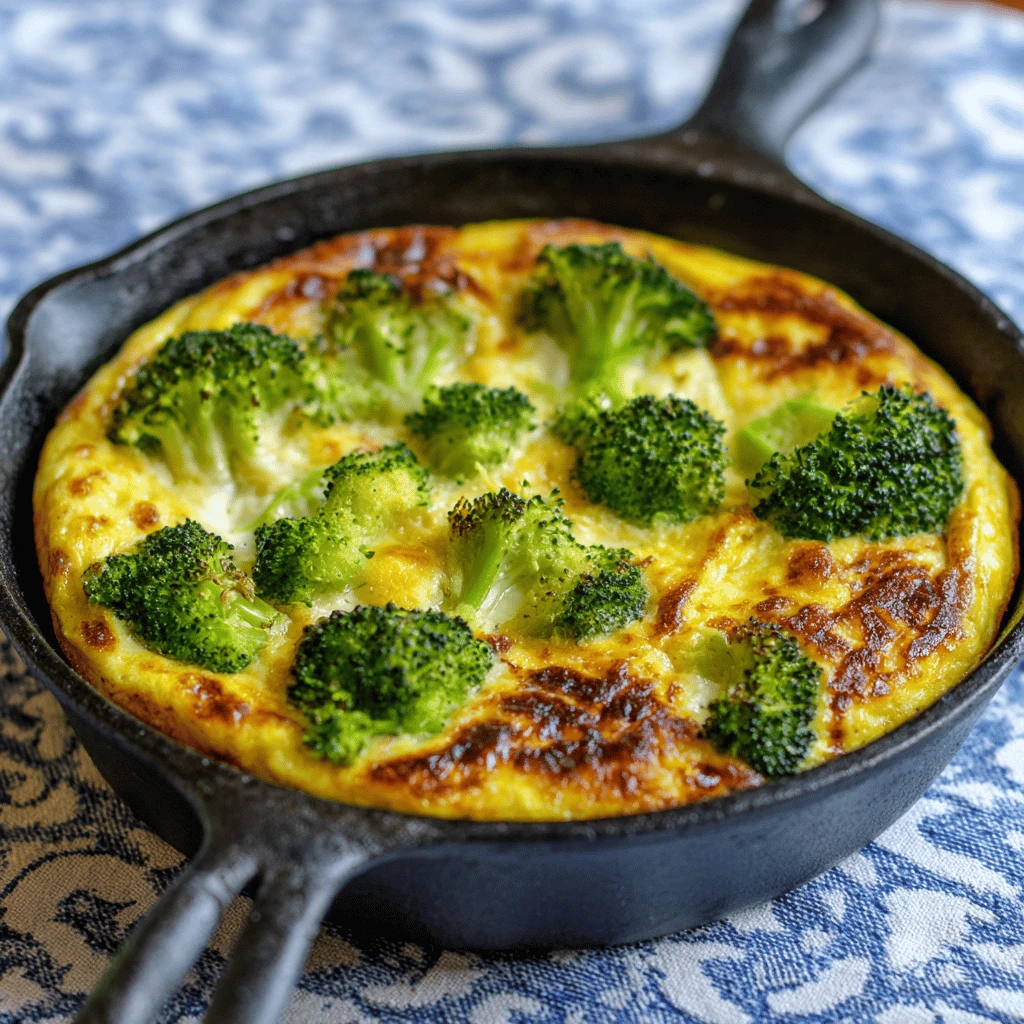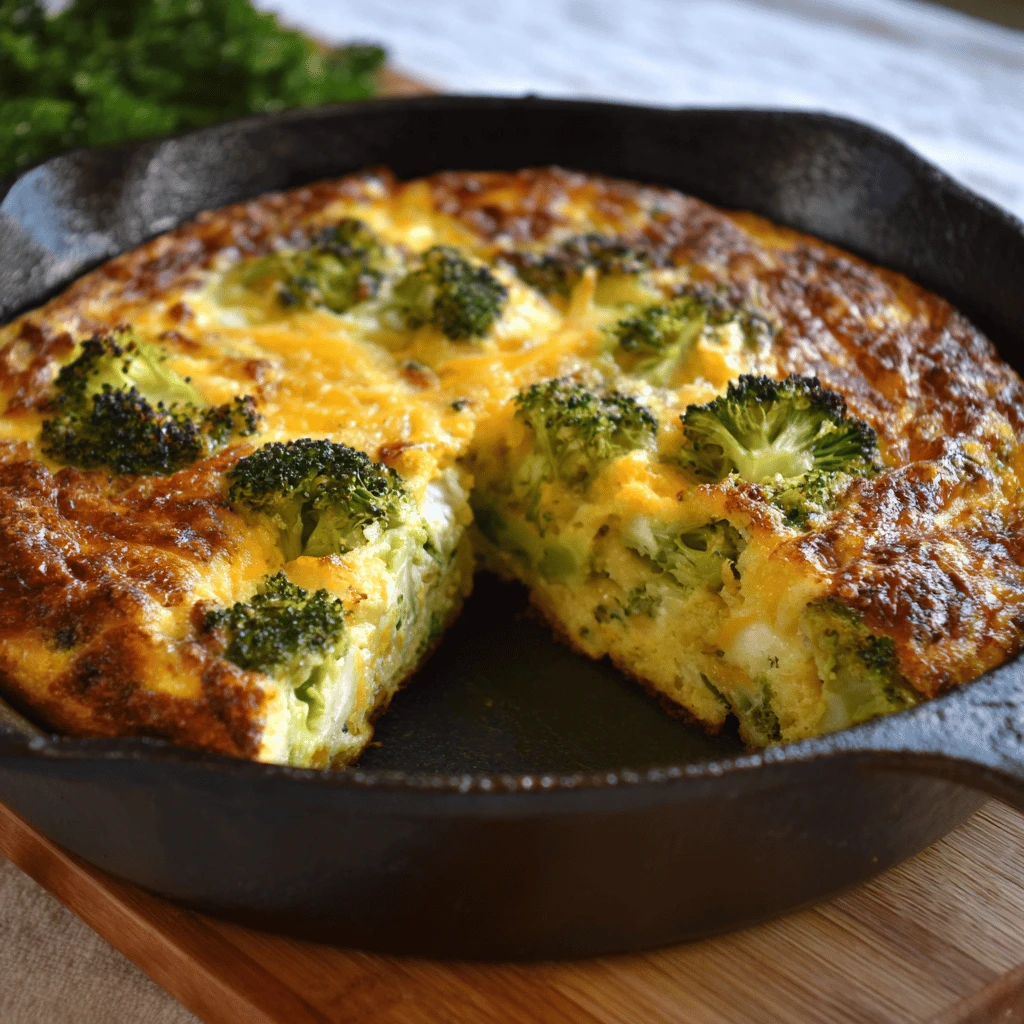Broccoli and Cheese Frittata: A Simple & Delicious Recipe
Frittatas are a fantastic way to enjoy a versatile and satisfying meal, perfect for breakfast, brunch, lunch, or even a light dinner. This broccoli and cheese frittata is a particularly delightful option, combining the earthy goodness of broccoli with the creamy, comforting richness of cheese. Easy to customize and incredibly adaptable, this recipe is a sure winner for busy weeknights or relaxed weekend mornings.

Why You’ll Love This Broccoli and Cheese Frittata
This frittata isn’t just delicious; it’s also incredibly practical. Here’s why it’s a must-try:
- Quick and Easy: This recipe requires minimal prep time and cooks quickly, making it perfect for busy schedules.
- Versatile: You can easily customize the ingredients to suit your preferences and what you have on hand. Swap out the cheese, add different vegetables, or incorporate cooked meats for a heartier meal.
- Healthy and Nutritious: Broccoli is packed with vitamins, minerals, and antioxidants, while eggs provide a great source of protein.
- Great for Leftovers: Frittatas taste just as good (if not better!) the next day, making them ideal for meal prepping or a quick lunch.
- Budget-Friendly: Eggs and broccoli are generally affordable ingredients, making this a cost-effective meal option.
The Perfect Broccoli and Cheese Frittata Recipe
This recipe provides a solid foundation for creating your own perfect broccoli and cheese frittata. Feel free to experiment with variations to suit your taste!
Ingredients:
- 6 large eggs
- 1/4 cup milk or cream
- 1/4 teaspoon salt
- 1/4 teaspoon black pepper
- 1 tablespoon olive oil
- 1 cup broccoli florets, chopped
- 1/2 cup shredded cheddar cheese (or your favorite cheese)
- Optional: 1/4 cup chopped onion or shallots
- Optional: 1 clove garlic, minced
Instructions:
1. Prepare the Broccoli: Steam, boil, or microwave the broccoli florets until they are tender-crisp. You want them cooked but still with a slight bite. Set aside.
2. Sauté Aromatics (Optional): If using onion or shallots and garlic, heat the olive oil in an oven-safe skillet (preferably cast iron) over medium heat. Sauté the onion or shallots until softened, about 5 minutes. Add the garlic and cook for another minute until fragrant.
3. Whisk the Eggs: In a bowl, whisk together the eggs, milk or cream, salt, and pepper until well combined.
4. Combine Ingredients: Add the cooked broccoli and shredded cheese to the skillet. Pour the egg mixture over the broccoli and cheese, making sure everything is evenly distributed.
5. Cook on the Stovetop: Cook the frittata on the stovetop over medium-low heat for about 10-15 minutes, or until the edges are set and the bottom is lightly golden.
6. Bake in the Oven: Preheat your oven to 350°F (175°C). Transfer the skillet to the preheated oven and bake for another 10-15 minutes, or until the frittata is set in the center and lightly browned on top. A toothpick inserted into the center should come out clean.
7. Cool and Serve: Let the frittata cool slightly before slicing and serving. You can serve it warm or at room temperature.
Tips for Success:
- Use an Oven-Safe Skillet: A cast iron skillet is ideal for frittatas because it distributes heat evenly and can go directly from the stovetop to the oven. However, any oven-safe skillet will work. If you don’t have an oven-safe skillet, you can transfer the frittata to a greased baking dish before baking.
- Don’t Overcook the Broccoli: Overcooked broccoli will become mushy in the frittata. Aim for tender-crisp.
- Customize the Cheese: Cheddar is a classic choice, but you can use any cheese you like, such as Gruyere, Monterey Jack, mozzarella, or feta.
- Add Other Vegetables: Feel free to add other vegetables to your frittata, such as mushrooms, spinach, bell peppers, or tomatoes.
- Season to Taste: Adjust the salt and pepper to your liking. You can also add other herbs and spices, such as paprika, thyme, or rosemary.
- Prevent Sticking: Make sure your skillet is well-seasoned or greased to prevent the frittata from sticking.
Variations and Add-Ins for Your Frittata
One of the best things about frittatas is their versatility. Here are some ideas for variations and add-ins to make this recipe your own:
- Meat Lovers: Add cooked bacon, sausage, ham, or prosciutto to the frittata for a heartier meal.
- Vegetarian Delight: Incorporate other vegetables like spinach, mushrooms, bell peppers, zucchini, or asparagus.
- Spice it Up: Add a pinch of red pepper flakes or a dash of hot sauce for a spicy kick.
- Herbaceous Flavor: Mix in fresh herbs like parsley, chives, basil, or oregano.
- Mediterranean Twist: Add sun-dried tomatoes, olives, and feta cheese for a Mediterranean-inspired frittata.
- Breakfast for Dinner: Serve with a side of toast, avocado, and fresh fruit for a complete breakfast-for-dinner meal.
- Dairy-Free Option: Substitute the milk or cream with plant-based milk, such as almond milk or soy milk.
- Cheese Variations: Try different cheese combinations like goat cheese and parmesan, or swiss and gruyere.
Serving and Storing Your Broccoli and Cheese Frittata
This frittata is delicious served warm, at room temperature, or even cold.

Serving Suggestions:
- Breakfast/Brunch: Serve with a side of toast, fruit salad, yogurt, or a smoothie.
- Lunch: Pack a slice of frittata for a quick and easy lunch. It pairs well with a side salad or soup.
- Dinner: Serve with a green salad and a crusty bread for a light and satisfying dinner.
- Appetizer: Cut the frittata into small squares and serve as an appetizer at a party or gathering.
Storing Leftovers:
- Refrigerate: Store leftover frittata in an airtight container in the refrigerator for up to 3-4 days.
- Reheat: Reheat the frittata in the microwave, oven, or stovetop until heated through.
- Freeze: You can also freeze frittata for longer storage. Wrap individual slices tightly in plastic wrap and then place them in a freezer bag. Frozen frittata can be stored for up to 2-3 months. Thaw in the refrigerator overnight before reheating.
Frequently Asked Questions (FAQ)
- Can I make this frittata ahead of time?
Yes, you can make the frittata ahead of time. It's great for meal prepping! Store it in the refrigerator and reheat it when you're ready to eat. It actually tastes better the next day as the flavors have time to meld together.
- Can I use frozen broccoli?
Yes, you can use frozen broccoli. Make sure to thaw it and drain any excess water before adding it to the frittata.
- What if I don’t have an oven-safe skillet?
If you don't have an oven-safe skillet, you can transfer the frittata to a greased baking dish before baking.
- How do I know when the frittata is done?
The frittata is done when the edges are set and the center is no longer wobbly. A toothpick inserted into the center should come out clean.
- Can I add meat to this frittata?
Absolutely! Cooked bacon, sausage, ham, or prosciutto are all great additions. Just make sure the meat is already cooked before adding it to the frittata.
- What kind of cheese works best in a frittata?
Cheddar is a classic choice, but you can use any cheese you like, such as Gruyere, Monterey Jack, mozzarella, feta, or even a combination of cheeses.
- Can I make this dairy-free?
Yes, substitute the milk or cream with plant-based milk, such as almond milk or soy milk. You can also use a dairy-free cheese alternative.
- How can I prevent the frittata from sticking to the pan?
Make sure your skillet is well-seasoned or greased to prevent the frittata from sticking. You can also line the bottom of the skillet with parchment paper.
- Can I use different vegetables?
Yes, feel free to experiment with different vegetables. Spinach, mushrooms, bell peppers, zucchini, and asparagus are all great additions.
- How long does a frittata last in the refrigerator?
A frittata will last for 3-4 days in the refrigerator when stored in an airtight container.



